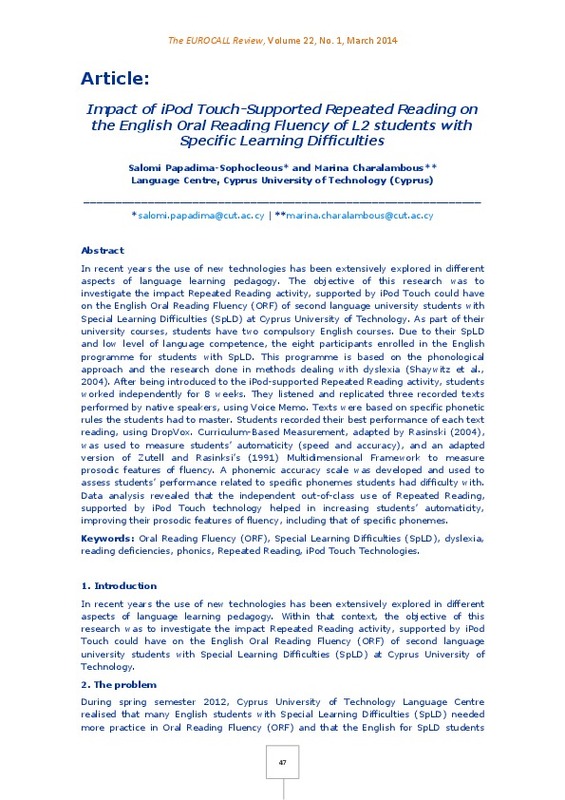JavaScript is disabled for your browser. Some features of this site may not work without it.
Buscar en RiuNet
Listar
Mi cuenta
Estadísticas
Ayuda RiuNet
Admin. UPV
Impact of iPod Touch-Supported Repeated Reading on the English Oral Reading Fluency of L2 students with Specific Learning Difficulties
Mostrar el registro sencillo del ítem
Ficheros en el ítem
| dc.contributor.author | Papadima-Sophocleous, Salomi
|
es_ES |
| dc.contributor.author | Charalambous, Marina
|
es_ES |
| dc.date.accessioned | 2017-05-26T07:16:10Z | |
| dc.date.available | 2017-05-26T07:16:10Z | |
| dc.date.issued | 2014-03-20 | |
| dc.identifier.uri | http://hdl.handle.net/10251/81801 | |
| dc.description.abstract | [EN] In recent years the use of new technologies has been extensively explored in different aspects of language learning pedagogy. The objective of this research was to investigate the impact Repeated Reading activity, supported by iPod Touch could have on the English Oral Reading Fluency (ORF) of second language university students with Special Learning Difficulties (SpLD) at Cyprus University of Technology. As part of their university courses, students have two compulsory English courses. Due to their SpLD and low level of language competence, the eight participants enrolled in the English programme for students with SpLD. This programme is based on the phonological approach and the research done in methods dealing with dyslexia (Shaywitz et al., 2004). After being introduced to the iPod-supported Repeated Reading activity, students worked independently for 8 weeks. They listened and replicated three recorded texts performed by native speakers, using Voice Memo. Texts were based on specific phonetic rules the students had to master. Students recorded their best performance of each text reading, using DropVox. Curriculum-Based Measurement, adapted by Rasinski (2004), was used to measure students’ automaticity (speed and accuracy), and an adapted version of Zutell and Rasinksi’s (1991) Multidimensional Framework to measure prosodic features of fluency. A phonemic accuracy scale was developed and used to assess students’ performance related to specific phonemes students had difficulty with. Data analysis revealed that the independent out-of-class use of Repeated Reading, supported by iPod Touch technology helped in increasing students’ automaticity, improving their prosodic features of fluency, including that of specific phonemes. | es_ES |
| dc.description.sponsorship | The authors would like to thank Mr. Yiannis Mallouris for his valuable input in this project, as well as the students who participated in the ESAP SpLD programme and the research project. Without their help, the project would not have been possible. This research was supported by the Start Up University Grant, allocated to the project during 2010-2012. | |
| dc.language | Inglés | es_ES |
| dc.publisher | Universitat Politècnica de València | |
| dc.relation.ispartof | The EuroCALL Review | |
| dc.rights | Reconocimiento - No comercial - Sin obra derivada (by-nc-nd) | es_ES |
| dc.subject | Oral reading fluency (ORF) | es_ES |
| dc.subject | Special learning difficulties (SpLD) | es_ES |
| dc.subject | Dyslexia | es_ES |
| dc.subject | Reading deficiencies | es_ES |
| dc.subject | Phonics | es_ES |
| dc.subject | Repeated reading | es_ES |
| dc.subject | iPod Touch technologies | es_ES |
| dc.title | Impact of iPod Touch-Supported Repeated Reading on the English Oral Reading Fluency of L2 students with Specific Learning Difficulties | es_ES |
| dc.type | Artículo | es_ES |
| dc.date.updated | 2017-05-25T11:29:38Z | |
| dc.identifier.doi | 10.4995/eurocall.2014.3639 | |
| dc.rights.accessRights | Abierto | es_ES |
| dc.description.bibliographicCitation | Papadima-Sophocleous, S.; Charalambous, M. (2014). Impact of iPod Touch-Supported Repeated Reading on the English Oral Reading Fluency of L2 students with Specific Learning Difficulties. The EuroCALL Review. 22(1):47-58. https://doi.org/10.4995/eurocall.2014.3639 | es_ES |
| dc.description.accrualMethod | SWORD | es_ES |
| dc.relation.publisherversion | https://doi.org/10.4995/eurocall.2014.3639 | es_ES |
| dc.description.upvformatpinicio | 47 | es_ES |
| dc.description.upvformatpfin | 58 | es_ES |
| dc.description.volume | 22 | |
| dc.description.issue | 1 | |
| dc.identifier.eissn | 1695-2618 |








